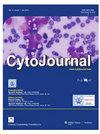Comparison of liquid based cytology and conventional smears on lymph node aspirates: A cytomorphological study
IF 2.5
4区 医学
Q2 PATHOLOGY
引用次数: 0
Abstract
In an era of minimally invasive and rapid diagnostic technologies, fine-needle aspiration cytology (FNAC) is most useful when it comes to patients with lymphadenopathies especially of the cervical region. Liquid-based cytology (LBC) is an alternative processing method which is used for both gynecological and non-gynecological samples. Because of the remarkable advantages of LBC smears in gynecological samples, nowadays, many studies have been done to assess its utility in various other lesions. Hereby, with the help of this study, we would like to evaluate the efficiency of LBC smears in comparison to conventional FNAC smears conventional smears (CS) on lymph node aspirates. A retrospective study was done over a 1-year period in which 253 cases of lymph node aspirates were included in the study. The slides were prepared using standard conventional and LBC techniques and compared for adequacy, cellularity, cell architecture, necrosis, background debris, presence of cells in monolayer sheets, and nuclear/cytoplasmic details. Of the total 253 cases, 171 (67.6%) were and 67 (26.5%) were diagnosed as non-neoplastic and malignant, respectively. Although the LBC smears were useful in the diagnosis of malignant cases, they did pose some challenges especially in the non-neoplastic lymph node aspirates due to loss of the background necrosis. In addition, the cellular yield in LBC smears was low in comparison to CS. LBC smears from lymph node aspirates results in better diagnostic accuracy for malignant cases due to better cellular and nuclear details. However, for non-neoplastic etiology, it should not be considered better than CS as loss of the background necrosis and inflammation may result in an incorrect diagnosis.淋巴结穿刺液基细胞学与传统涂片的比较:细胞形态学研究
在采用微创和快速诊断技术的时代,细针穿刺细胞学检查(FNAC)对淋巴腺疾病(尤其是宫颈淋巴腺疾病)患者最为有用。液基细胞学(LBC)是另一种处理方法,可用于妇科和非妇科样本。由于液基细胞涂片在妇科样本中的显著优势,如今已有许多研究对其在其他各种病变中的实用性进行了评估。在本研究的帮助下,我们希望评估 LBC 涂片与常规 FNAC 涂片、常规涂片(CS)在淋巴结抽吸物中的应用效果。这项回顾性研究历时 1 年,共纳入了 253 例淋巴结抽吸样本,采用标准的常规和 LBC 技术制备切片,并对切片的充分性、细胞性、细胞结构、坏死、背景碎屑、单层片状细胞的存在以及核/胞质细节进行比较。虽然 LBC 涂片有助于诊断恶性病例,但也带来了一些挑战,尤其是在非肿瘤性淋巴结穿刺中,因为背景坏死消失了。此外,与 CS 相比,LBC 涂片的细胞产量较低。淋巴结抽吸物的 LBC 涂片对恶性病例的诊断准确性更高,因为细胞和核的细节更清晰。然而,对于非肿瘤性病因,LBC涂片并不比CS更好,因为失去了坏死和炎症的背景可能会导致诊断错误。
本文章由计算机程序翻译,如有差异,请以英文原文为准。
求助全文
约1分钟内获得全文
求助全文
来源期刊

Cytojournal
PATHOLOGY-
CiteScore
2.20
自引率
42.10%
发文量
56
审稿时长
>12 weeks
期刊介绍:
The CytoJournal is an open-access peer-reviewed journal committed to publishing high-quality articles in the field of Diagnostic Cytopathology including Molecular aspects. The journal is owned by the Cytopathology Foundation and published by the Scientific Scholar.
 求助内容:
求助内容: 应助结果提醒方式:
应助结果提醒方式:


